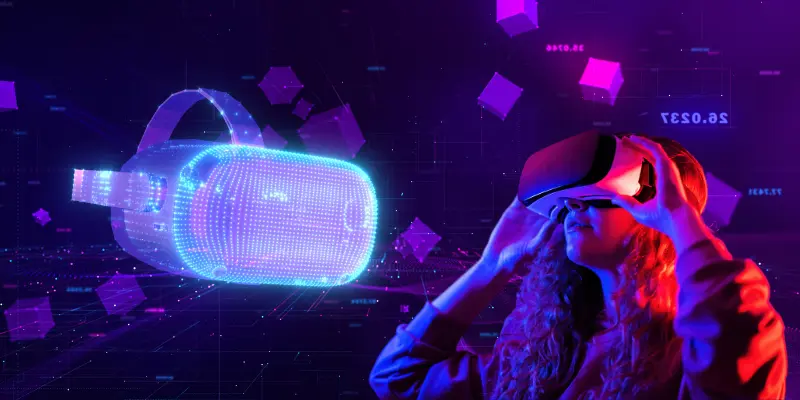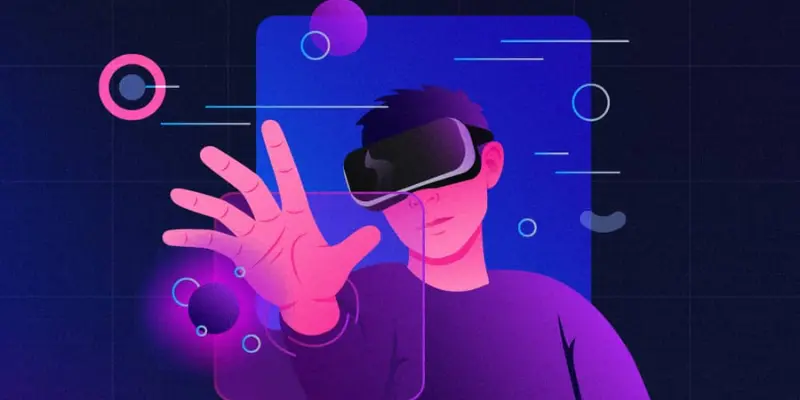Recent years have witnessed an extraordinary transformation in the fitness industry due to AR VR in Fitness Industry. Not only have these immersive technologies revolutionized exercise routines, but they have also altered their very meaning by making fitness fun. This paradigm shift has created a novel approach to keeping fit and healthy that makes workouts more engaging while reaching wider audiences.
AR and VR technologies have transformed the fitness industry by injecting entertainment and interactivity into workout routines through gamification. This transformational trend, known as the 'gamification of fitness" within the AR VR in Fitness Industry, is inspiring individuals towards healthier living lifestyles more than ever before. Mobile app development services play an instrumental role in this transformation. Their services help create user-friendly, engaging fitness applications that seamlessly incorporate AR and VR technologies. Not only do these apps keep tabs on physical activities, but they also offer rich and engaging experiences to keep users active - mobile app developers are at the forefront of designing intuitive user interfaces, implementing 3D visuals.
VR/AR Impacts on Fitness
 AR/VR technology is reshaping the fitness industry, fundamentally transforming how we maintain our fitness and well-being. Join us in exploring the transformative potential of AR VR in the fitness industry!
AR/VR technology is reshaping the fitness industry, fundamentally transforming how we maintain our fitness and well-being. Join us in exploring the transformative potential of AR VR in the fitness industry!
Creating Immersive Workouts
VR/AR in fitness offers users a new dimension of immersion. Donning a VR headset, fitness enthusiasts can transport themselves into various virtual environments while exercising - be it vibrant landscapes, scenic routes, or group classes held virtually - for an engaging workout experience.
Personalization and Adaptation
One of the key benefits of AR in fitness is its ability to offer tailored workout programs. AI algorithms-powered fitness app solutions and platforms can analyze user information such as fitness levels, preferences, and goals to design customized exercise routines that best meet their individual needs.
Overcoming Workout Monotony
Traditional workouts can quickly become routine and uninspiring over time, diminishing motivation and enthusiasm. VR/AR adds an element of novelty and excitement by providing virtual fitness training options like environments, classes, and challenges that keep fitness routines fresh and engaging for users.
Enhancing Rehabilitation and Physical Therapy
Virtual reality/augmented reality technology has proven to be an invaluable asset in physical therapy and rehabilitation settings, aiding motor skill recovery, balance training, and pain management during therapy sessions. Virtual scenarios can also be created to simulate realistic scenarios designed to aid in motor skill recovery, balance training, or pain management sessions.
Fostering Community and Social Interactions
VR/AR fitness platforms create a sense of community among their users, offering like-minded individuals and opportunity to network, join group workouts, support each other's fitness goals regardless of physical location, and stay accountable in their journey towards fitness. This sense of belonging helps users remain motivated in their fitness journey while remaining accountable.
Staying Motivated
Exercise can be challenging for a number of reasons, including lack of motivation; AR and VR technologies can help combat this by making exercise simple with programs like AR Fitness Tracker that remind users when to exercise or guide them through each phase of training sessions - helping keep individuals on the path towards physical activity and staying healthy! Staying Motivated
Entertainment
Everyone looking to stay in shape needs motivation if exercise is going to be enjoyable. Unfortunately, physical activity may not come naturally for some. Staying Motivated Staying motivated in physical activity becomes much simpler thanks to AR/VR technology, which makes exercise simple as well. Keep track of workout sessions by scheduling reminders so you won't miss a single fitness session! Plus, these programs help guide through each phase of training sessions, making exercise simple while giving guidance through each phase. Exercise can be both healthy and entertaining. AR can make physical fitness sessions even more pleasurable by helping to make them enjoyable, using gadgets or apps with AR capability to make virtual reality workouts more engaging. AR for physical exercise allows users to incorporate interactive elements like video gaming into their workout regimen - adding excitement and adventure with rowing machines or zombie apocalypse scenes during VR workout sessions that make training sessions even more captivating.
Real-Time Data
Every industry, such as health and wellness, depends heavily on data. Fitness businesses that rely on augmented reality require data in order to make training decisions and assess the effects of various activities on your body. AR and VR technologies have become invaluable tools for consumers looking to understand the intensity of their activities - apps like VR fitness are available now to keep us fit and in check, and wearable gadgets can track everything from your distance traveled while running or cycling to heart rate, giving users valuable information they can use when making future exercise decisions - data that could help make decisions that could influence future exercises and keep us motivated in shape and on schedule!
Offers New Workout Ways
Establishing an exercise routine on an ongoing basis can be daunting. Many find the same routines tiresome. By adding technology into your workouts, however, technology can make your sessions seem fresh each time. AR and VR technologies offer opportunities for exploring more unique exercises; use these to explore different workouts without repeating yourself over and over. There are even apps designed specifically to meet training requirements, which enable you to change workout sessions!
VR Fitness and Flexibility
One of the greatest developments in this field is being able to recreate a gym experience at home through AR/VR technology. People no longer have to travel far for physical training sessions since these gadgets provide everything needed from home. Augmented reality gadgets that simulate gym environments with instructors have become increasingly popular - especially since this allows you more freedom in terms of flexibility: you can continue training even when physical gyms are closed by using virtual reality gear at home instead. Also, AR training equipment comes equipped with software that tracks strength data, which enables users to easily adjust the intensity accordingly for workouts as required - offering plenty of training possibilities at home.
Keeps Track of Your Health
Exercise can help people maintain a healthy lifestyle. Unfortunately, doing so without technology may be challenging; that's why AR and VR technology has gained so much traction today. These bits of tech are used in some apps to monitor training sessions - giving us insight into your progress quickly; data from these programs also allows us to determine whether your workouts are effective as well as which exercises we should perform more often to enhance them further.
Competition and Shared Workouts
Competing and exchanging experiences are two methods to enhance training. Although this can happen in the gym, this doesn't have to be the case - meeting and mixing during peak epidemic times was an absolute nightmare - at home by creating a virtual reality gym. Augmented reality applications allow individuals to compete and share experiences from any location; you could even record and share virtual reality training sessions and statistics with fellow users - which encourages people to be more motivated, create healthy competition, and make learning simpler!
AR/VR Trends in the Fitness Industry: Transforming Workouts and Wellness

Recent AR/VR trends within the fitness industry showcase their potential to amplify workouts, engage users, and boost overall health and well-being.
Interactive Workouts
One of the newest trends in the fitness industry is using AR/VR platforms to provide interactive workouts. AR/VR provides users with dynamic exercise routines at home while creating virtual group classes guided by expert trainers for increased participation even from distant places.
Customized Fitness
AR and VR technologies have the potential to offer highly tailored fitness experiences thanks to AI-powered algorithms and user data analysis. By tailoring workouts according to each person's fitness level, preferences, and goals - not only do AR/VR technologies improve results, but they can keep users engaged on their fitness journey.
Gamification of Fitness
Gamification can be used to incentivize exercise. AR/VR platforms have leveraged gaming elements into workouts to make exercise an engaging and addictive activity for users - offering competition among friends, rewards for successful completion, and challenging activities to add a layer of competition and make fitness enjoyable and exciting.
Virtual Training Partners
Loneliness and lack of motivation can be major obstacles to regular exercise. AR/VR technologies provide virtual training partners that offer encouragement and guidance during workouts - offering tips, corrections, and positive reinforcement just like an actual trainer would!
Accessible Fitness
AR/VR fitness platforms are providing exercise to a broader population, including people living with physical disabilities or health conditions. By adapting workouts and providing inclusive experiences, these technologies are helping break down barriers within the fitness industry and promote inclusivity.
Health and Wellness Tracking
Advanced AR/VR fitness systems feature integrated health and wellness tracking features that enable users to track their heart rate, calories burned, and other metrics in real time - providing essential data that allows individuals to make informed decisions regarding their fitness routines and overall well-being.
Mind-Body Connection
AR/VR technology goes beyond physical exercise to foster mind-body connections. Meditation and mindfulness apps in VR offer serene environments to create relaxation, reduce stress levels, and promote holistic well-being.
Rehabilitation and Physical Therapy
AR/VR has become an invaluable asset in physical rehabilitation and therapy programs. Patients recovering from injuries or surgeries can access customized therapy programs in virtual reality environments to increase motivation and adherence to treatment plans.
Fitness Equipment Integration
Another emerging trend in AR/VR usage is the integration of fitness equipment with virtual reality experiences, such as treadmills and stationary bikes that now offer immersive virtual environments reminiscent of scenic locales or racing scenarios while users work.
Social Connection
AR/VR fitness platforms can serve as an avenue for people to build connections with friends and family through virtual workouts, regardless of geographical distances, forging an unparalleled sense of togetherness among users.
Market Growth
The AR/VR fitness market is experiencing rapid expansion, drawing investments and startup ventures alike. As its technology becomes more affordable for wider consumers, its reach may expand within the fitness industry as a whole.
Healthcare Partnerships
Healthcare is increasingly recognizing the potential of AR/VR for preventative and rehabilitative uses, and partnerships between fitness companies and healthcare providers have begun forming to create holistic approaches to health and wellbeing.
Nutritional Integration
AR/VR fitness platforms are increasingly providing users with nutritional guidance so they can gain access to information on healthy eating habits and recipe recommendations, as well as visualize their dietary decisions in immersive environments.
At-Home Gyms
With the increase of in-home fitness solutions, AR/VR is turning living rooms into virtual gyms - saving users both time and money while providing personalized workouts tailored specifically for them.
Data Security and Privacy
While AR/VR fitness platforms collect sensitive health data, increasing emphasis is placed on data security and privacy measures to protect user information and ensure it remains confidential. Industry must strive to find solutions.
Content Diversification
AR/VR fitness content is rapidly diversifying. Users have the choice between yoga, HIIT training, dance, and martial arts sessions. There's sure to be something suitable for everyone!
Real-World Applications
AR/VR fitness technologies have proven their worth beyond recreational use by finding applications in professional sports training, military fitness programs, and physical therapy clinics. They're showing value across different fields.
Education and Certification
The fitness industry is becoming aware of the need for skilled AR/VR trainers and instructors, with educational programs and certification courses emerging to train professionals on creating safe virtual fitness experiences.
Integration With Wearable Devices
Integrating wearable devices like smartwatches and fitness trackers enhances the fitness experience. Users can receive real-time feedback and performance metrics that further optimize their workouts.
Sustainability
With AR/VR being rapidly adopted within the fitness industry, there has been an increased emphasis on sustainability. Businesses are exploring eco-friendly hardware and software solutions in order to minimize their environmental footprint.
Mobile Application Development Security Tips for the Fitness Industry.
 Here are a few essential mobile application security tips in the fitness industry:
Here are a few essential mobile application security tips in the fitness industry:
- Data Encryption:Employ robust data encryption techniques to safeguard user information during transmission and storage. Ensure secure protocols like HTTPS ensure data remains encrypted during communications between apps and servers.
- Authentication and Authorization:Implement strong authentication methods such as multi-factor authentication (MFA) to verify users' identities, while role-based access control restricts sensitive data or functionalities only to those authorized users.
- Securing APIs:Ensure the security of your APIs by employing authentication mechanisms like OAuth 2.0 and API keys, conducting regular audits to check for vulnerabilities, and employing rate limiting to prevent abuse.
- Data Minimization:Only collect the essential information required for app functionality, avoid unnecessary storage space usage, and provide users with clear privacy policies that explain how their information will be utilized and protected.
- User Privacy:Give user privacy top priority by seeking explicit consent before collecting data, giving users the ability to control what information is shared, and regularly auditing third-party SDKs and libraries for potential privacy risks.
- Secure Coding Practices:Train your development team on secure coding practices. Conduct regular code reviews and use tools such as static code analysis to identify security vulnerabilities early in the development process and take immediate steps to address them.
- Secure File Handling:Be extra wary when handling user-generated content, such as photos and videos uploaded from social networks such as Flickr or YouTube. Use file validation technology to prevent malicious uploads and ensure files are stored safely.
- Penetration Testing:Conduct periodic penetration testing to proactively discover vulnerabilities in your application and correct them before malicious actors exploit them. By being proactive about security flaws in your code base, regular penetration tests help identify flaws before malicious actors exploit them and expose security vulnerabilities that could otherwise go undetected.
- Security Updates:Ensure your application and its dependencies stay protected with the latest security patches by quickly responding to any identified vulnerabilities to ensure maximum protection of the app's security.
- Implement Secure Payment Processing:If your fitness app involves transactions, ensure secure payment processing with industry-standard encryption and in accordance with the Payment Card Industry Data Security Standard (PCI DSS).
- Cloud Security:If you store user data in the cloud, be sure to select a trustworthy cloud provider with appropriate access controls and encryption settings while regularly reviewing and revising their measures for added protection.
- User Education:Provide your users with education on the importance of secure passwords, login practices, and how to recognize phishing attempts—a guide for setting up their accounts securely.
- Incident Response Plan:Draft an incident response plan that addresses data breaches and security incidents efficiently. Ensure your team has been trained to respond quickly in order to minimize damage.
- Compliance:Get familiar with applicable data protection regulations, such as the General Data Protection Regulation (GDPR) or the Health Insurance Portability and Accountability Act (HIPAA),to ensure your app complies with them.
- Third-Party Audits and Certifications:Undergoing third-party security audits and certifications is one way to demonstrate your commitment to both users and investors alike.
- 16. User Feedback:Encourage users to report security issues and vulnerabilities through an easy and user-friendly channel and quickly investigate and address any reported incidents to continuously strengthen your app's security.
Conclusion
The introduction of AR VR in Fitness Industry has unquestionably opened a new chapter of engagement and motivation among fitness enthusiasts. Immersive experiences provided through AR/VR applications have changed how individuals view and pursue fitness goals; we have seen how AR and VR add gamification elements that make workouts more engaging and interactive than ever. AR VR in Fitness Industry have seen tremendous success for several key reasons. First of all, these cutting-edge tools give users a truly engaging sense of adventure and innovation, effectively combatting monotony while encouraging unwavering dedication towards fitness routines. Second, competition and social interactions facilitated by AR/VR apps create supportive communities that encourage them to push past boundaries to reach higher performance goals; lastly, data-driven insights provide users with greater insights into their fitness journey. Partnership with an AR VR app development company is key for tapping the full potential of AR and VR in fitness. It will allow businesses to take full advantage of these technologies. Such companies possess the expertise to design applications that not only deliver an immersive experience but also meet industry goals. As technology progresses further, gamification of fitness will only continue to enhance workout experiences, making workouts more engaging and effective than ever. Often asked questions can provide insight.
FAQs
1. What role is AR VR playing in the fitness industry?
Augmented and virtual reality technologies are playing an increasingly significant role in making fitness routines more engaging and motivational for many participants. Creating virtual environments and augmenting reality overlays that facilitate these gamified fitness routines can become much more enjoyable and engaging experiences than before.
2. How Can AR and VR Gamify Fitness?
AR VR is used to gamify fitness by creating interactive and visually stimulating workouts. VR allows users to enter virtual worlds and compete in fitness challenges. At the same time, AR can overlay digital information onto real-world environments, thereby adding game elements to exercise routines.
3. Are there any examples of AR VR fitness games?
For example, VR boxing lets users fight virtual opponents; AR apps offer real-world locations as fitness adventures, such as running from zombies or collecting virtual items while running.
4. Can AR VR improve motivation in the fitness industry?
AR / VR can significantly increase motivation. Gamification features like rewards, leaderboards, and achievements motivate users to stick with their workout regimen and set new goals for themselves.
5. Are There Any Fitness Apps Utilizing AR VR Technology?
Yes, many fitness apps incorporate AR VR elements. A few popular examples are Beat Saber (VR),which combines rhythm-based gameplay with exercise, and Pokemon GO (AR),which encourages outdoor physical activity.













Share this blog